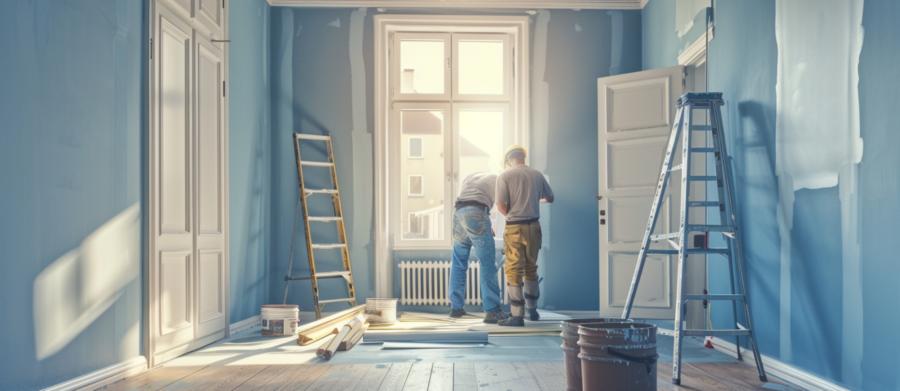Color Theory: The Magic of Light and Shade
When it comes to creating the illusion of space, color theory is your best friend. Lighter colors tend to make a room feel airy and open, while darker shades can create a more intimate and cozy atmosphere. But there’s more to it than just slapping some white paint on the walls.Consider using a monochromatic color scheme, where different shades of the same color are used throughout the room. This creates a seamless look that makes the space appear larger. For example, a pale blue on the walls paired with slightly darker blue accents can give the illusion of depth and space.
Accent Walls: Bold Moves in Small Spaces
Accent walls can be a game-changer in small rooms. By painting one wall in a bold color while keeping the others light, you draw the eye to the focal point, creating the perception of a larger area. It’s like magic, but without the need for a wand or top hat.A deep navy or rich emerald green on one wall can add a sense of depth, making the room feel bigger. Just be careful not to go overboard with the color, or you might end up with a room that feels more like a cave than a cozy nook.
Optical Illusions: Tricks of the Trade
Now, let’s talk about some optical illusions that can trick the eye into seeing more space than there actually is. One popular technique is using horizontal stripes. Painting stripes on the walls can make a room look wider, while vertical stripes can make the ceiling seem higher. Just remember, we’re talking about paint here, not fashion advice.Another trick is to paint the ceiling a lighter color than the walls. This draws the eye upward, making the room feel taller. Alternatively, if you’re feeling adventurous, a glossy finish on the ceiling can reflect light and give the illusion of more space.
Contrast and Continuity: Balancing Act
Creating contrast can also be effective in expanding a room’s appearance. Painting trim and moldings in a lighter color than the walls can make the walls feel like they’re receding. This contrast adds depth and dimension to the room. For example, light gray walls with crisp white trim can make the room feel larger and more open.On the flip side, continuity can also play a vital role. Using the same color on the walls, trim, and even the doors can create a continuous look that expands the space. This technique blurs the boundaries of the room, making it feel more expansive.
Reflective Surfaces: Bouncing Light Around
Mirrors aren’t the only way to reflect light and create the illusion of space. Glossy paint finishes can also do the trick. While matte finishes absorb light, glossy or semi-gloss finishes reflect it, making the room feel brighter and larger. Just be careful with the application – you want to avoid any unintentional disco ball effects.Incorporating metallic or pearlized paint can add a subtle shimmer that catches the light and adds a sense of depth to the room. A soft gold or silver accent wall can create a luxurious feel without overwhelming the space.
Furniture Camouflage: Blending In
One often-overlooked trick is to paint furniture the same color as the walls. This technique makes large pieces of furniture blend into the background, reducing visual clutter and making the room feel more spacious. Imagine a bookshelf painted to match the wall – it almost disappears, leaving the space feeling less crowded.Similarly, you can use this strategy with built-in furniture. By painting built-in cabinets and shelves the same color as the walls, you create a cohesive look that extends the visual boundaries of the room.
Light it Up: Enhancing Paint with Lighting
Lighting plays a crucial role in how paint colors are perceived. Natural light can make a space feel larger and more inviting, while artificial lighting can either enhance or detract from your paint choices. When planning your room’s color scheme, consider the type and amount of lighting the space receives.For rooms with limited natural light, opt for lighter paint colors that can reflect available light. Complement these with strategically placed lamps and fixtures that highlight the walls and corners, making the room feel larger. Remember, a well-lit room always appears more spacious.
Ceiling Creativity: Raising the Roof
Often neglected in decorating, the ceiling can be a secret weapon in making a room feel more spacious. Painting the ceiling a lighter color than the walls can create the illusion of height, while adding subtle stripes or patterns can draw the eye upward.If you really want to get creative, consider a high-gloss finish or even a mirrored ceiling to reflect light and add depth. Just make sure it complements the overall style of the room – nobody wants to feel like they’re living in a funhouse.
Wrapping Up
Transforming a small room into a more spacious-feeling sanctuary is all about smart paint choices and clever application techniques. By understanding and applying color theory, utilizing accent walls, creating optical illusions, and experimenting with reflective surfaces and lighting, you can make any small space feel larger and more inviting.Remember, your home is your canvas, and a little creativity can go a long way in turning cramped quarters into a roomier retreat. So grab your paintbrush, channel your inner artist, and start creating the illusion of space – no magic wand required.
Article kindly provided by winnipegpaintingtechs.com


